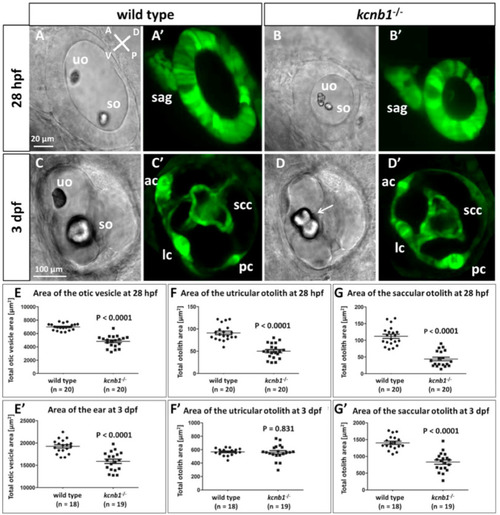Fig. 2
- ID
- ZDB-FIG-210316-22
- Publication
- Jedrychowska et al., 2020 - Kcnb1 plays a role in development of the inner ear
- Other Figures
- All Figure Page
- Back to All Figure Page
|
Fig. 2. Mutation of kcnb1 causes defects in the developing ear. At 28 hpf (A, B) and 3 dpf (C, D) kcnb1−/− mutants develop smaller ears and otoliths compared with wildtype controls. Fused otoliths in mutant ears at 3 dpf are shown (arrow). A′-D′, The ET33-mi2A transgenic line was used as a background to characterize inner ear morphology. Mutants developed all main elements of the inner ear despite the small size of mutant ears. E-G’’ Morphometric analysis of the size of the ears and otoliths at 28 hpf and 3 dpf. Both otoliths were small in 28 hpf mutants compared with the wildtype controls. By 3 dpf, the utricular otolith reached the same size as in wildtype controls, unlike the saccular otolith, which remained small. Data are expressed as mean ± SEM, unpaired Student’s t-test. Imaging was performed using light-sheet fluorescence microscopy (20 × objective). ac, anterior crista; dpf, days post fertilization; hpf, hours post fertilization; lc, lateral crista; pc, posterior crista; sag, VIII statoacoustic ganglion; scc, semicircular canals; so, saccular otolith; uo, utricular otolith. |
Reprinted from Developmental Biology, 471, Jedrychowska, J., Gasanov, E.V., Korzh, V., Kcnb1 plays a role in development of the inner ear, 65-75, Copyright (2020) with permission from Elsevier. Full text @ Dev. Biol.

